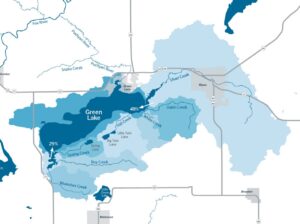green lake association request for information:
Phosphorus & duckweed mitigation solutions, technologies or systems

On behalf of Green Lake Association (GLA) in central Wisconsin, USA, The Water Council is managing a Request for Information (RFI) seeking effective and proven technologies, materials, nature-based systems, or engineered solutions for addressing excessive phosphorus and duckweed loading in ambient waters.
Background
Green Lake is Wisconsin’s deepest two-story glacial lake covering an area of 7,660 acres and is listed as an impaired water body for low dissolved oxygen (DO) caused by phosphorus loading (formerly an oligotrophic lake and now listed as an impaired metalimnetic oxygen minima caused by phosphorus). Multiple studies have been performed and it is estimated that Green Lake will need a 50-70% reduction in controllable phosphorus loading (16,625 pounds per year) to meet its water quality goals.
Hundreds of best management practices (BMPs) are already being executed and, in 2023 alone, lake management partners expect over $1.1M USD in grant funding for watershed BMPs. It is known that nearly 80% of annual phosphorus loading flows through two shallow estuaries, on the west and east ends of the lake, entering the main waterbody under two bridges. The eastern estuary is also the primary location of duckweed production on Green Lake.
description
The GLA is interested in exploring solutions and technologies to complement their BMPs and intercept the phosphorus inflow from these two primary loading sources (pinch points). Some conceptual ideas include but are not limited to: 1) sediment inactivation (internal loading capping), 2) phosphorus interception (in-stream treatment), 3) nutrient reduction facilities (off-line treatment solutions), 4) wetland restoration, and/or 5) duckweed harvesting.
Additional information and background can be viewed below.
Innovative, commercially ready and deployable solutions, technologies or engineered solutions are sought for this RFI including proven solutions which:
- Address conceptual areas of sediment inactivation, phosphorus interception, nutrient reduction facilities, wetland restoration, or duckweed harvesting
- Significantly contribute to the 50-70% reduction goals for phosphorus loading
- Complement the existing BMPs being deployed
- Do no harm and cause no adverse environmental or habitat impacts
- Potentially consider recovery of phosphorus or related materials for beneficial use
key success criteria
- Prefer solutions that are commercially ready and available, though open to solutions that are in-development
- Proven track record with defensible results and outcomes for sought issue, or solid data supporting performance
- Additional successful reference projects or research
- Provides both short term and ongoing reduction/mitigation of phosphorus
Disclaimer: This is a request for information (RFI) ONLY to learn about solutions to mitigate phosphorus as described above. There is NO funding, prize, pilot, or outcome other than collecting applications for review and evaluation. The GLA will review all submissions and determine which solutions may be considered for follow-up meetings or exchange of additional information.
additional resources
General Information
- Green Lake Association Website (link here)
- Video: Seeking Solutions for Green Lake (link here)
- Green Lake Site Map (link here)
- Conceptual Site Model (link here)
- Green Lake Nine Key Elements Plan (report and appendices)
- 2022 USGS Report, Response of Green Lake, Wisconsin, to Changes in Phosphorus Loading, With Special Emphasis on Near-Surface Total Phosphorus Concentrations and Metalimnetic Dissolved Oxygen Minima (report here)
- 2022 McDonald et al, Temperature explains the formation of a metalimnetic oxygen minimum in a deep mesotrophic lake (report here)
- Bathymetric mapping layers (here)
- USGS Inflow Data and Concentrations (datasets)
- Nelson Institute GIS page (link here)
Approach 1: Internal Loading Treatment / Sediment Inactivation
- 2023 EutroPHIX Sediment Evaluation to Assess Water Quality Restoration (report here)
- 2019 Garrison, Paleoecology of the 2016 Sediment Core from Green Lake’s Eastern Basin (report here)
Approach 2: In-Stream Treatment / Phosphorus Mitigation
- 2023 Prellwitz, Diagnostic & Feasibility Study Findings (report here)
Approach 3: Off-line Treatment / Nutrient Reduction Facilities
- EPA Dixie Drain (project example here)
Approach 4: Wetland Restoration
- 2019 Fuller, Temporal and Spatial Variation of Nutrients and Sediment in the Marshes of Green Lake (thesis here)
Approach 5: Duckweed Harvesting
- 2022 USGS, Monitoring the input of duckweed and the associated phosphorus input into Green Lake, Wisconsin using machine learning with particle image velocimetry (proposal here)